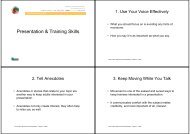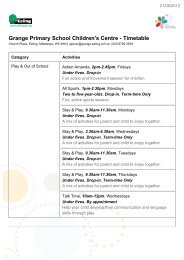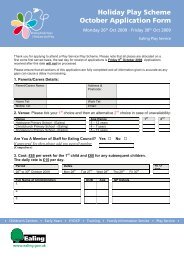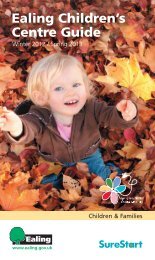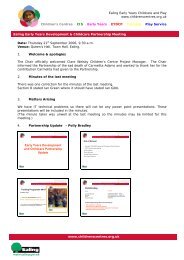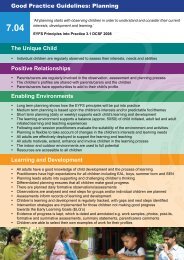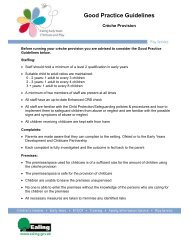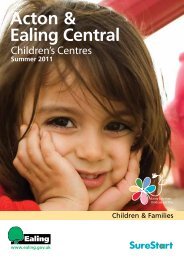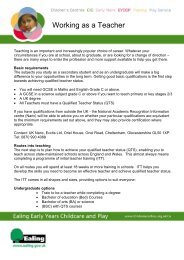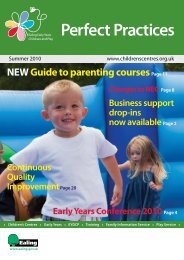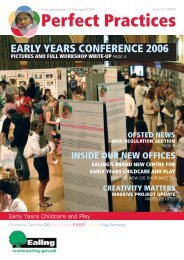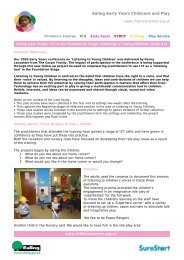Phonic Tracking Sheet - Children's Centres
Phonic Tracking Sheet - Children's Centres
Phonic Tracking Sheet - Children's Centres
Create successful ePaper yourself
Turn your PDF publications into a flip-book with our unique Google optimized e-Paper software.
Primary National Strategy<br />
<strong>Phonic</strong>s Progress <strong>Tracking</strong> <strong>Sheet</strong> - Early Years Foundation Stage through Key Stage 1<br />
Class: Teacher: 2006 – 2007<br />
Progression Autumn term Spring term Summer term<br />
Phase 6<br />
Phase 5<br />
Phase 4<br />
Phase 3<br />
Phase<br />
3iii<br />
Phase<br />
3ii<br />
Phase<br />
3i<br />
Phase 2<br />
Phase 1<br />
Primary National Strategy<br />
© Crown Copyright 2006
Primary National Strategy<br />
Guidance on use of the <strong>Phonic</strong> Progress <strong>Tracking</strong> <strong>Sheet</strong><br />
The Rose Review highlights the importance of careful assessment:<br />
‘Assessment for learning is vital for planning work that is matched well to children’s<br />
needs’ Para 59<br />
‘The most effective assessment was simple, rigorous and purposeful’. Para 61 1<br />
1. This tracking sheet spans the Foundation Stage and Key Stage 1 and therefore<br />
the information should be transferred as children move between year groups<br />
2. You should enter children’s names into the relevant box when they begin to work<br />
within that phase.<br />
3. For summative assessment purposes such as reporting or completing the<br />
Foundation Stage Profile, you should ensure that the phase descriptor is the best<br />
fit for the child’s current level of achievement. The child should be using their<br />
phonic knowledge and skills independently and consistently.<br />
Phase Descriptors<br />
Children working within Phase 6::<br />
• Apply their phonic skills and knowledge to recognise and spell an increasing<br />
number of complex words<br />
• Are secure with less common grapheme - phoneme correspondences e.g s /zh/<br />
• Can recognise phonic irregularities<br />
Children working within Phase 5:<br />
• Can use alternative ways of pronouncing and spelling the graphemes<br />
corresponding to the long vowel phonemes e.g. /oe/ o-e, o,oa,ow e.g. snake<br />
• Can read phonically decodable two and three syllable words, e.g. bleating,<br />
frogspawn, shopkeeper<br />
• Can spell complex word using phonically plausible attempts<br />
Children working within Phase 4:<br />
• Can blend adjacent consonants in words and apply this skill when reading<br />
unfamiliar texts e.g. spoon, cried, nest<br />
• Can segment adjacent consonants in words and apply this in spelling<br />
Children working within Phase 3:<br />
• know one grapheme for each of the 44 phonemes<br />
Within Phase 3iii<br />
1 Independent review of the teaching of early reading. Final Report, Jim Rose, March 2006<br />
Primary National Strategy<br />
© Crown Copyright 2006
Primary National Strategy<br />
Children can read and spell a wide range of CVC words using all letters and less<br />
frequent consonant digraphs and some long vowel phonemes e.g. sheep, boat<br />
Within Phase 3ii<br />
Children can read and spell CVC words using a wider range of letters, short vowels,<br />
some consonant digraphs and double letters e.g. bell, chick<br />
Within Phase 3i<br />
Children can read and spell a few CVC words using a limited range of letters and short<br />
vowels e.g box<br />
Children working within Phase 2:<br />
• Know that words are constructed from phonemes and that phonemes are<br />
represented by graphemes<br />
• Know a small selection of common consonants and vowels which they can blend<br />
for reading and segment for spelling simple cvc words e.g. sit and tap<br />
Children working within Phase 1:<br />
• explore and experiment with sounds and words<br />
• distinguish between different sounds in the environment and phonemes<br />
• show awareness of rhyme and alliteration<br />
Primary National Strategy<br />
© Crown Copyright 2006



